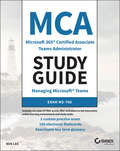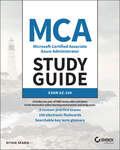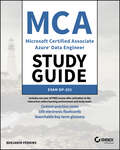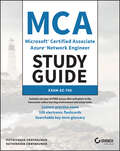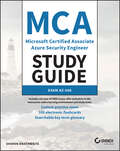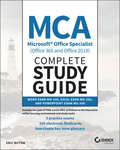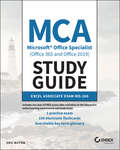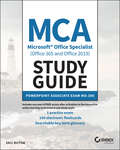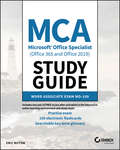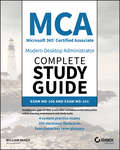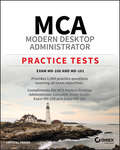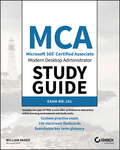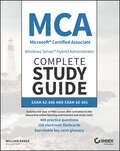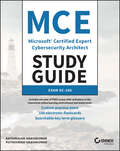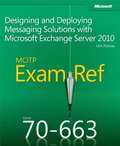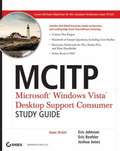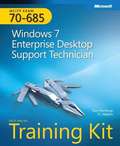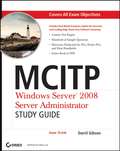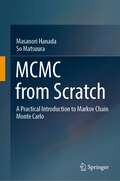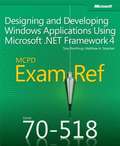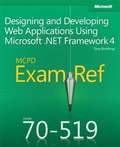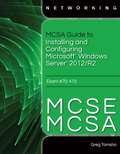- Table View
- List View
MC Microsoft Certified Azure Fundamentals Study Guide: Exam AZ-900 (Sybex Study Guide)
by Jim BoyceThe fastest and most effective way to learn the fundamentals of Azure cloud technology and prepare for the AZ-900 certification exam The newly updated second edition of MC Microsoft Certified Azure Fundamentals Study Guide is an accurate and up-to-date roadmap to the AZ-900 certification exam and a reliable, effective resource for everyone seeking to learn about or reinforce their knowledge of Azure services, pricing, security and compliance, resource management, and more. In the book, experienced Microsoft Principal Customer Success Account Manager and long-time author, Jim Boyce, covers every foundational Azure competency, including: General and foundational cloud concepts Azure Core Services, including architecture, subscription and billing options, data services, and virtual machines Azure Core Networking Services, like virtual networks, load balancers, and VPN gateways Security, compliance, privacy, and trust features Azure Solutions, like AI and machine learning, serverless computing, and IoT Azure pricing, service levels, and lifecycles Azure Resource creation and management Ideal for technical and non-technical professionals alike, this straightforward Study Guide draws on the proven Sybex model to explain core Azure features and concepts. It will get you ready to succeed on the widely used AZ-900 certification test and elevate your understanding of Azure cloud software, improving your day-to-day performance in any role that directly or indirectly intersects with the cloud platform. Inside the book End-of-chapter review questions, with answers and explanations, you can use to measure your progress and help you focus on the areas where you need to improve Concise and intuitive explanations of core Azure services, functions, and features Complimentary access to the superior Sybex online learning environment and test bank, including practice test questions, digital flashcards, and a glossary of key terms With authoritative, concise coverage of all relevant cloud concepts, Azure architecture and services, and management and governance features tested by the AZ-900 certification exam, this edition of MC Microsoft Certified Azure Fundamentals Study Guide is the fastest, most efficient way to get up to speed on foundational Azure cloud competencies.
MCA Microsoft 365 Certified Associate Modern Desktop Administrator Complete Study Guide with 900 Practice Test Questions: Exam MD-100 and Exam MD-101
by William PanekComplete, UPDATED study guide for MCA Modern Desktop Administrator certification exams, MD-100 and MD-101. Covers new Windows 11, services, technologies, and more! MCA Microsoft 365 Certified Associate Modern Desktop Administrator Complete Study Guide, Second Edition, is your all-in-one guide to preparing for the exams that will earn you the MCA Modern Desktop Administrator certification! In this book, well-known Windows guru and five-time Microsoft MVP, William Panek, guides you through the latest versions of the Windows Client exam (MD-100) and the Managing Modern Desktops exam (MD-101). This one-stop resource covers 100% of the objectives for both exams, providing real world scenarios, hands-on exercises, and challenging review questions. You’ll also dive deeper into some of the more complex topics and technologies, including deploying, maintaining, and upgrading Windows; managing devices and data; configuring storage and connectivity; managing apps and data; and more. Learn everything you need to know to pass the MD-100 and MD-101 exams Earn your MCA Modern Desktop Administrator certification to launch or advance your career Access exercises, review questions, flashcards, and practice exams, in the book and online Master all of the test objectives for the latest exam versions—updated for Windows 11With this study guide, you also get access to Sybex’s superior online learning environment, including an assessment test, hundreds of practice exams, flashcards, searchable glossary, and videos for many of the chapter exercises. This is the perfect test prep resource for admins preparing for certification and anyone looking to upgrade their existing skills to Microsoft’s latest desktop client.
MCA Microsoft 365 Teams Administrator Study Guide: Exam MS-700
by Ben LeeThis Study Guide helps you understand the job role and responsibilities of a Microsoft 365 Teams Administrator. It's your one-stop resource for learning new skills, preparing to take the exam, and boosting your career! Cloud technology has become a major component of how services are delivered to customers. It's creating new roles and expanding others in all areas of technology. The Microsoft 365 Certified Associate Teams Administrator certification shows you're keeping pace with today's technology. MCA Microsoft 365 Certified Teams Administrator Study Guide is your best resource for understanding the job roles and responsibilities of a Teams Administrator and preparing to take the certification Exam MS-700. Microsoft 365 Teams Administrators focus on efficient and effective collaboration and communication in an enterprise environment. This Study Guide can help you understand best practices for configuring, deploying, and managing Office 365 workloads for Microsoft Teams that focus on efficient and effective collaboration and communication in an enterprise environment. Test your knowledge of all key exam objectives, including planning, deploying, and managing Teams chat, apps, channels, meetings, audio conferencing, live events, and calling. This Sybex Study Guide also covers upgrading from Skype for Business to Teams, managing Teams settings by using PowerShell, and understanding integration points with other apps and services. Review everything you need to know to pass the Exam MS-700 and you’re your Microsoft 365 Certified Associate Teams Administrator certification Use Sybex’s exclusive online test bank to improve your ability to plan and configure a Microsoft Teams Environment Master the process of managing Chat, Calling, and Meetings within Microsoft Teams Become an expert at configuring Teams and App Policies, including integrating third-party apps and services Readers will also have access to Sybex's online test bank, including hundreds of practice questions, flashcards, and a glossary. Take your career to a new level with this Study Guide!
MCA Microsoft Certified Associate Azure Administrator Study Guide: Exam AZ-104
by Rithin SkariaLearn what it takes to be an Azure Administrator and efficiently prepare for Exam AZ-104 with this authoritative resource MCA Microsoft 365 Azure Administrator Study Guide: Exam AZ-104 prepares readers to take the AZ-104 Exam and to fully understand the role of a Microsoft 365 Azure Administrator. The book takes a practical and straightforward approach to Microsoft Azure, ensuring that you understand both the realities of working as an Administrator and the techniques and skills necessary to succeed on the AZ-104 Exam. In addition to providing you with access to the online Sybex test bank that includes hundreds of practice questions, flashcards, and a glossary of terms, the study guide comprehensively explains all the following topics: How to manage Azure subscriptions and resources Implementing and managing storage Deploying and managing virtual machines Managing and configuring virtual networks How to Manage identities Perfect for anyone considering a career as a Microsoft Azure Administrator or preparing for the AZ-104 Exam, MCA Microsoft 365 Azure Administrator Study Guide: Exam AZ-104 also belongs on the bookshelves of practicing administrators who wish to brush up on the fundamentals of their profession.
MCA Microsoft Certified Associate Azure Data Engineer Study Guide: Exam DP-203
by Benjamin PerkinsPrepare for the Azure Data Engineering certification—and an exciting new career in analytics—with this must-have study aide In the MCA Microsoft Certified Associate Azure Data Engineer Study Guide: Exam DP-203, accomplished data engineer and tech educator Benjamin Perkins delivers a hands-on, practical guide to preparing for the challenging Azure Data Engineer certification and for a new career in an exciting and growing field of tech. In the book, you’ll explore all the objectives covered on the DP-203 exam while learning the job roles and responsibilities of a newly minted Azure data engineer. From integrating, transforming, and consolidating data from various structured and unstructured data systems into a structure that is suitable for building analytics solutions, you’ll get up to speed quickly and efficiently with Sybex’s easy-to-use study aids and tools. This Study Guide also offers: Career-ready advice for anyone hoping to ace their first data engineering job interview and excel in their first day in the field Indispensable tips and tricks to familiarize yourself with the DP-203 exam structure and help reduce test anxiety Complimentary access to Sybex’s expansive online study tools, accessible across multiple devices, and offering access to hundreds of bonus practice questions, electronic flashcards, and a searchable, digital glossary of key terms A one-of-a-kind study aid designed to help you get straight to the crucial material you need to succeed on the exam and on the job, the MCA Microsoft Certified Associate Azure Data Engineer Study Guide: Exam DP-203 belongs on the bookshelves of anyone hoping to increase their data analytics skills, advance their data engineering career with an in-demand certification, or hoping to make a career change into a popular new area of tech.
MCA Microsoft Certified Associate Azure Network Engineer Study Guide: Exam AZ-700
by Puthiyavan Udayakumar Kathiravan UdayakumarPrepare to take the NEW Exam AZ-700 with confidence and launch your career as an Azure Network Engineer Not only does MCA Microsoft Certified Associate Azure Network Engineer Study Guide: Exam AZ-700 help you prepare for your certification exam, it takes a deep dive into the role and responsibilities of an Azure Network Engineer, so you can learn what to expect in your new career. You&’ll also have access to additional online study tools, including hundreds of bonus practice exam questions, electronic flashcards, and a searchable glossary of important terms. Prepare smarter with Sybex's superior interactive online learning environment and test bank. Exam AZ-700, Designing and Implementing Microsoft Azure Networking Solutions, measures your ability to design, implement, manage, secure, and monitor technical tasks such as hybrid networking; core networking infrastructure; routing; networks; and private access to Azure services. With this in-demand certification, you can qualify for jobs as an Azure Network Engineer, where you will work with solution architects, cloud administrators, security engineers, application developers, and DevOps engineers to deliver Azure solutions. This study guide covers 100% of the objectives and all key concepts, including: Design, Implement, and Manage Hybrid Networking Design and Implement Core Networking Infrastructure Design and Implement Routing Secure and Monitor Networks Design and Implement Private Access to Azure Services If you&’re ready to become the go-to person for recommending, planning, and implementing Azure networking solutions, you&’ll need certification with Exam AZ-700. This is your one-stop study guide to feel confident and prepared on test day. Trust the proven Sybex self-study approach to validate your skills and to help you achieve your career goals!
MCA Microsoft Certified Associate Azure Security Engineer Study Guide: Exam AZ-500
by Shimon BrathwaitePrepare for the MCA Azure Security Engineer certification exam faster and smarter with help from Sybex In the MCA Microsoft Certified Associate Azure Security Engineer Study Guide: Exam AZ-500, cybersecurity veteran Shimon Brathwaite walks you through every step you need to take to prepare for the MCA Azure Security Engineer certification exam and a career in Azure cybersecurity. You&’ll find coverage of every domain competency tested by the exam, including identity management and access, platform protection implementation, security operations management, and data and application security. You&’ll learn to maintain the security posture of an Azure environment, implement threat protection, and respond to security incident escalations. Readers will also find: Efficient and accurate coverage of every topic necessary to succeed on the MCA Azure Security Engineer exam Robust discussions of all the skills you need to hit the ground running at your first—or next—Azure cybersecurity job Complementary access to online study tools, including hundreds of bonus practice exam questions, electronic flashcards, and a searchable glossaryThe MCA Azure Security Engineer AZ-500 exam is a challenging barrier to certification. But you can prepare confidently and quickly with this latest expert resource from Sybex. It&’s ideal for anyone preparing for the AZ-500 exam or seeking to step into their next role as an Azure security engineer.
MCA Microsoft Office Specialist (Office 365 and Office 2019) Complete Study Guide: Word Exam MO-100, Excel Exam MO-200, and PowerPoint Exam MO-300
by Eric ButowMaster one of the most essential skill sets for the contemporary office As Microsoft Office becomes ever more ubiquitous in modern offices across the world, competence and familiarity with its intricacies is more important than ever. Now you can set yourself apart from the pack and prove your skills with the Microsoft Office Specialist certification. The MCA Microsoft Office Specialist (Office 365 and Office 2019) Complete Study Guide : Word Associate Exam MO-100, Excel Associate Exam MO-200, and PowerPoint Associate Exam MO-300 delivers a comprehensive roadmap to achieving the certification with easy-to-follow instruction for each of the three required proficiencies: Word, Excel, and PowerPoint. You’ll enjoy access to chapter review questions and Exam Essentials, a feature that identifies critical subject areas. Discover practical, hands-on exercises that prepare you for real-world roles and jobs, and gain valuable experience as you reinforce key Microsoft Office skills that you’ll be expected to demonstrate in job interviews and your day-to-day professional life. Learn to manage and create text documents in Word, perform operations with formulas in Excel, and create engaging slideshows and presentations in PowerPoint. This practical book also provides: Fully updated information for the latest Microsoft Office Specialist certification exams covering Microsoft Office 365 Access to new career opportunities with a professional certification that’s relevant to virtually any office environment Access to the Sybex online study tools, with chapter review questions, full-length practice exams, hundreds of electronic flashcards, and a glossary of key terms The MCA Microsoft Office Specialist (Office 365 and Office 2019) Complete Study Guide offers crystal-clear organization, comprehensive coverage, and easy-to-understand instruction. It’s perfect for anyone who hopes to prove their skills with the Microsoft Office Specialist certification or to improve their mastery of Microsoft Office 365.
MCA Microsoft Office Specialist (Office 365 and Office 2019) Study Guide: Excel Associate Exam MO-200
by Eric ButowMCA Microsoft Office Specialist Study Guide: Excel Associate Exam MO-200 is your roadmap to preparing for taking the MO-200 exam and earning the Excel Associate (Excel and Excel 2019) certification. The following objectives are covered: Manage worksheets and workbooks Manage data cells and ranges Manage tables and table data Perform operations by using formulas and functions Manage charts Major topics include the fundamentals of creating and managing worksheets and workbooks, creating cells and ranges, creating tables, applying formulas and functions, and creating charts and objects. This Study Guide also covers the ability to create and edit a workbook with multiple sheets and use a graphic element to represent data visually. Workbook examples include professional-looking budgets, financial statements, team performance charts, sales invoices, and data entry logs.Readers will also have access to Sybex's superior online test bank, includng hundreds of practice questions, flashcards, and a glossary of important terms.
MCA Microsoft Office Specialist (Office 365 and Office 2019) Study Guide: PowerPoint Associate Exam MO-300
by Eric ButowMCA Microsoft Office Specialist Study Guide: PowerPoint Associate Exam MO-300 is your roadmap to preparing for taking the MO-300 exam and earning the PowerPoint Associate (PowerPoint and PowerPoint 2019) certification. The following objectives are covered: Manage presentations Manage slides Insert and format text, shapes, and images Insert tables, charts, smartArt, 3D models, and media Apply transitions and animations Major topics include creating, editing, and enhancing presentations and slideshows, including the ability to create and manage presentations, insert and format shapes and slides, create slide content, apply transitions and animations, and manage multiple presentations. This Study Guide also covers creating professional-grade sales presentations, employee training, instructional materials, and kiosk slideshows.Readers will also have access to Sybex's superior online test bank, includng hundreds of practice questions, flashcards, and a glossary of important terms.
MCA Microsoft Office Specialist (Office 365 and Office 2019) Study Guide: Word Associate Exam MO-100
by Eric ButowLearn the realities of being a Microsoft Office Specialist and efficiently prepare for the Word Associate MO-100 Exam with a single, comprehensive study guide MCA Microsoft Office Specialist Study Guide: Word Associate Exam MO-100 comprehensively prepares you for the MO-100 Exam. Accomplished and experienced author Eric Butow provides readers with a one-stop resource for learning the job responsibilities of a Microsoft Office Specialist and succeeding on the MO-100 Exam. The study guide is written in a straightforward and practical style which, when combined with the companion online Sybex resources, allows you to learn efficiently and effectively. The online resources include hundreds of practice questions, flashcards, and a glossary of key terms. In addition to preparing you for the realities of the Microsoft Office Specialist job role, this study guide covers all the subjects necessary to do well on the certifying exam, including: Managing documents Inserting and formatting text, paragraphs, and sections Managing tables and lists Creating and managing references Inserting and formatting graphics Managing document collaboration Perfect for anyone seeking to begin a new career as a Microsoft Office Specialist, or simply wondering what the job entails, the Study Guide also belongs on the bookshelf of currently practicing professionals who want to brush up on the fundamentals of their role.
MCA Modern Desktop Administrator Complete Study Guide: Exam MD-100 and Exam MD-101
by William PanekThe ultimate study guide for Microsoft 365 Certified Associate (MCA) Modern Desktop certification—covers the new Exam MD-100 and the new Exam MD-101 in one book! Referred to as the Modern Desktop, Microsoft 365 is Microsoft’s new suite of modern workplace services comprising Windows 10, Office 365, and Enterprise Mobility & Security. IT administrators tasked with deploying and implementing Modern Desktop are required to configure, secure, manage, and monitor devices and applications in enterprise environments. Success on the MCA Modern Desktop Administrator certification exam is essential for IT professionals seeking to expand their job opportunities and advance their careers. The MCA Modern Desktop Administrator Complete Study Guide is an indispensable resource for candidates preparing for certification. This guide covers 100% of all exam objectives for the new Exam MD-100: Windows 10 and the new Exam-101: Managing Modern Desktops. All aspects of both new exams are covered, including in-depth information on advanced topics and technologies. Included is access to Sybex's comprehensive online learning environment—offering an assessment test, bonus practice exams, electronic flashcards, a searchable glossary, and videos for many of the chapter exercises. This must-have guide enables users to: Configure devices, core services, networking, storage, users, updates, and system and data recovery Implement, install, maintain, manage, and monitor Windows 10 Plan desktop deployment and Microsoft Intune device management solutions Manage identities, applications, remote access, and data access and protection Review real-world scenarios, hands-on exercises, and challenging practice questions The MCA Modern Desktop Administrator Complete Study Guide: Exam MD-100 and Exam MD-101 is an essential tool for anyone preparing for the exams and students and IT professionals looking to learn new skills or upgrade their existing skills.
MCA Modern Desktop Administrator Practice Tests: Exam MD-100 and MD-101
by Crystal PanekEXAM MD-100 AND MD-101 Provides 1,000 practice questions covering all exam objectives. Compliments the MCA Modern Desktop Administrator Complete Study Guide: Exam MD-100 and Exam MD-101 Quick, focused review for MD-100 and MD-101 Microsoft's new Certified Associate Modern Desktop qualification verifies your skill as an administrator of Windows 10 technologies and modern desktop management. With a focus on the intricacies of Microsoft 365, this certification is in high demand. The 2 practice exams PLUS domain-by-domain questions in this book will help you target your study and sharpen your focus—1000 questions total! So now tackle the certification exam with confidence. Expertly crafted questions cover 100% of the objectives for both the MD-100 and MD-101 exams, enabling you to be fully prepared. Coverage of 100% of all exam objectives in these practice tests means you'll be ready for: Desktop and Device Deployment Windows Management and Monitoring OS Updates and Upgrades Core Services Support Data Access and Usage Networking Security Driver and Device Installation Remote Access Configuration System Backup and Restore Interactive learning environment Take your exam prep to the next level with Sybex's superior interactive online study tools. To access our learning environment, simply visit www.wiley.com/go/sybextestprep, register to receive your unique PIN, and instantly gain one year of FREE access to the interactive test bank with two practice exams and domain-by-domain questions. 1000 questions total! Interactive test bank Use the interactive online version of the book's 2 practice exams to help you identify areas where further review is needed. Get more than 90% of the answers correct, and you're ready to take the certification exam. 100 questions total! ABOUT THE MCA PROGRAM The MCA Microsoft 365 Certified: Modern Desktop Administrator Associate certification helps Modern Desktop Administrators deploy, configure, secure, manage, and monitor devices and client applications in an enterprise environment. Exam MD-100, Windows 10, measures your ability to accomplish the following technical tasks: deploy Windows; manage devices and data; configure connectivity; and maintain Windows. Exam MD-101, Managing Modern Desktops, measures your ability to accomplish the following technical tasks: deploy and update operating systems; manage policies and profiles; manage and protect devices; and manage apps and data. Visit www.microsoft.com/en-us/ learning/modern-desktop.aspx for more information.
MCA Modern Desktop Administrator Study Guide: Exam MD-100
by William PanekThe essential study guide for the new Microsoft 365 Certified Associate (MCA) Modern Desktop certification—covers Exam MD-100: Windows 10! The new Microsoft 365 Certified Associate (MCA) Modern Desktop certification exam measures a candidate’s ability to deploy Windows, manage devices and data, configure connectivity, and maintain Windows. MCA certification, sought by a growing number of employers, is an important part of any IT professional’s resume. The MCA Modern Desktop Administrator Study Guide: Exam MD-100 is a must-have book for anyone preparing for certification. This clear and accurate study guide covers 100% of exam objectives—providing hands-on exercises, challenging review questions, full explanations, and real-world examples. From the intricacies of Windows deployment to advanced security and enterprise capabilities, each chapter explains everything candidates need to know for passing the exam and earning MCA certification. This accurate, up-to-date study guide is designed to prepare administrators to deploy, configure, secure, manage, and monitor devices and client applications in an enterprise environment. Access to Sybex's comprehensive online learning environment—comprising a self-assessment test, a bonus practice exam, flashcards, a searchable glossary, and chapter exercise videos—is included to fully prepare for exam day. This study guide: Covers all Exam: MD-100 objectives Prepares readers to implement, install, and configure Windows 10 Reinforces comprehension and retention of central exam topics Helps readers learn new skills or upgrade existing skills to Microsoft's latest desktop client Demand for competent IT professionals is already high and continues to grow at a rapid pace. The MCA Modern Desktop Administrator Study Guide: Exam MD-100 is a valuable resource for preparing for the new Exam MD-100 and MCA certification.
MCA Modern Desktop Administrator Study Guide: Exam MD-101
by William PanekThe must-have preparation guide for MCA Modern Desktop certification—covers the new Exam MD-101: Managing Modern Desktops! Microsoft’s Modern Desktop integrates Windows 10, Office 365, and advanced security capabilities. Microsoft 365 Certified Associate (MCA) Modern Desktop certification candidates need to be familiar with Microsoft 365 workloads and demonstrate proficiency in deploying, configuring, and maintaining Windows 10 and non-Windows devices and technologies. The new Exam MD-101: Managing Modern Desktops measures candidate’s ability to deploy and update operating systems, manage policies and profiles, manage and protect devices, and manage apps and data. Candidates are required to know how to perform a range of tasks to pass the exam and earn certification. The MCA Modern Desktop Administrator Study Guide: Exam MD-101 provides in-depth examination of the complexities of Microsoft 365. Focusing on the job role of IT administrators, this clear, authoritative guide covers 100% of the new exam objectives. Real-world examples, detailed explanations, practical exercises, and challenging review questions help readers fully prepare for the exam. Sybex's comprehensive online learning environment—in which candidates can access an assessment test, electronic flash cards, a searchable glossary, bonus practice exams, and videos for chapter exercises—is included to provide comprehensive exam preparation. Topics include: Planning and implementing Windows 10 using dynamic deployment and Windows Autopilot Upgrading devices to Windows 10 and managing updates and device authentication Managing access polices, compliance policies, and device and user profiles Implementing and managing Windows Defender and Intune device enrollment Deploying and updating applications and implementing Mobile Application Management (MAM) The move to Windows 10 has greatly increased the demand for qualified and certified desktop administrators in corporate and enterprise settings. MCA Modern Desktop Administrator Study Guide: Exam MD-101: Managing Modern Desktops is an invaluable resource for IT professionals seeking MCA certification.
MCA Windows Server Hybrid Administrator Complete Study Guide with 400 Practice Test Questions: Exam AZ-800 and Exam AZ-801
by William PanekYour 2-exams-in-1 study guide for the next-gen Windows Server 2022 certification In MCA Windows Server Hybrid Administrator Complete Study Guide: Exam AZ-800 and Exam AZ-801, five-time Microsoft MVP and veteran IT trainer William Panek delivers a one-stop resource to help you efficiently prepare for and pass the required exams for Microsoft’s latest Windows Server certification. In the book, you’ll learn to expertly administer Windows Server workloads and services using on-premises, hybrid, and cloud technologies. The book provides hands-on explanations of all relevant Windows Server administration tasks, from security to migration, monitoring, troubleshooting, disaster recovery, and more. You’ll also find: 100% coverage of the objectives of each of the exams required to access an in-demand and lucrative new certification The skills and tools you’ll need to succeed as a newly minted Windows Server 2022 administrator Complimentary access to Sybex’ superior interactive online learning environment and test bank, which offers hundreds of practice questions, flashcards, and a glossaryA practical and indispensable resource for anyone seeking to acquire the brand-new MCA Windows Server Hybrid Administrator certification, MCA Windows Server Hybrid Administrator Complete Study Guide also deserves a place in the libraries of aspiring and practicing network and system administrators looking for an actionable guide to on-premises, hybrid, and cloud Windows Server 2022 environments.
MCE Microsoft Certified Expert Cybersecurity Architect Study Guide: Exam SC-100
by Puthiyavan Udayakumar Kathiravan UdayakumarPrep for the SC-100 exam like a pro with Sybex’ latest Study Guide In the MCE Microsoft Certified Expert Cybersecurity Architect Study Guide: Exam SC-100, a team of dedicated software architects delivers an authoritative and easy-to-follow guide to preparing for the SC-100 Cybersecurity Architect certification exam offered by Microsoft. In the book, you’ll find comprehensive coverage of the objectives tested by the exam, covering the evaluation of Governance Risk Compliance technical and security operations strategies, the design of Zero Trust strategies and architectures, and data and application strategy design. With the information provided by the authors, you’ll be prepared for your first day in a new role as a cybersecurity architect, gaining practical, hands-on skills with modern Azure deployments. You’ll also find: In-depth discussions of every single objective covered by the SC-100 exam and, by extension, the skills necessary to succeed as a Microsoft cybersecurity architect Critical information to help you obtain a widely sought-after credential that is increasingly popular across the industry (especially in government roles) Valuable online study tools, including hundreds of bonus practice exam questions, electronic flashcards, and a searchable glossary of crucial technical termsAn essential roadmap to the SC-100 exam and a new career in cybersecurity architecture on the Microsoft Azure cloud platform, MCE Microsoft Certified Expert Cybersecurity Architect Study Guide: Exam SC-100 is also ideal for anyone seeking to improve their knowledge and understanding of cloud-based management and security.
MCITP 70-663 Exam Ref: Designing and Deploying Messaging Solutions with Microsoft® Exchange Server 2010
by Orin ThomasProfessional-level prep for the professional-level exam. Prepare for MCITP Exam 70-663--and help demonstrate your real-world mastery of enterprise messaging administration with Microsoft Exchange Server. Designed for experienced, MCTS-certified professionals ready to advance their status--Exam Ref focuses on the critical-thinking and decision-making acumen needed for success at the MCITP level. Focus on the expertise measured by these objectives: Planning the Exchange Server 2010 Infrastructure Deploying the Exchange Server 2010 Infrastructure Designing and Deploying Security for the Exchange Organization Designing and Deploying Exchange Server 2010 Availability and Recovery Designing and Deploying Messaging Compliance, System Monitoring, and Reporting
MCITP Microsoft Windows Vista Desktop Support Consumer: Study Guide (70-623)
by Eric Johnson Eric BeehlerThis comprehensive guide takes readers through Microsoft's new certification, MCITP, and offers them the skills required to pass the Microsoft 70-623 exam on supporting and troubleshooting applications.
MCITP Self-Paced Training Kit (Exam 70-685): Windows 7 Enterprise Desktop Support Technician
by Tony Northrup J. C. MackinThis training kit is designed for IT support personnel who support Windows 7 at the Tier 1 or Tier 2 level in a wide range of environments and who plan to take the Microsoft Certified Information Technology Professional (MCITP) exam 70-685.
MCITP: Windows Server 2008 Server Administrator Study Guide
by Darril GibsonMaster Windows Server 2008 and navigate every detail of Microsoft's new MCITP: Windows Server 2008 Server Administrator exam with the information in MCITP: Windows Server 2008 Administration Study Guide (Exam 70-646, with CD). Learn the infrastructure, Web, and IT application servers and also how to use scripts and batch files to accomplish tasks on a regular basis. As a Server Administrator, you will understand how to manage the server operating system, file, and directory services, distribute software, patches, and updates, profile and monitor assigned servers, and troubleshoot.For Instructors: Teaching supplements are available for this title.
MCMC from Scratch: A Practical Introduction to Markov Chain Monte Carlo
by Masanori Hanada So MatsuuraThis textbook explains the fundamentals of Markov Chain Monte Carlo (MCMC) without assuming advanced knowledge of mathematics and programming. MCMC is a powerful technique that can be used to integrate complicated functions or to handle complicated probability distributions. MCMC is frequently used in diverse fields where statistical methods are important – e.g. Bayesian statistics, quantum physics, machine learning, computer science, computational biology, and mathematical economics. This book aims to equip readers with a sound understanding of MCMC and enable them to write simulation codes by themselves. The content consists of six chapters. Following Chap. 2, which introduces readers to the Monte Carlo algorithm and highlights the advantages of MCMC, Chap. 3 presents the general aspects of MCMC. Chap. 4 illustrates the essence of MCMC through the simple example of the Metropolis algorithm. In turn, Chap. 5 explains the HMC algorithm, Gibbs sampling algorithm and Metropolis-Hastings algorithm, discussing their pros, cons and pitfalls. Lastly, Chap. 6 presents several applications of MCMC. Including a wealth of examples and exercises with solutions, as well as sample codes and further math topics in the Appendix, this book offers a valuable asset for students and beginners in various fields.
MCPD 70-518 Exam Ref: Designing and Developing Windows® Applications Using Microsoft® .NET Framework 4
by Tony Northrup Matthew A. StoeckerProfessional-level prep for the professional-level exam. Prepare for MCPD Exam 70-518--and help demonstrate your real-world mastery of Windows application design and development with .NET Framework 4. Designed for experienced, MCTS-certified professionals ready to advance their status--Exam Ref focuses on the critical-thinking and decision-making acumen needed for success at the MCPD level. Focus on the expertise measured by these objectives: Designing the Layers of a Solution Designing the Presentation Layer Designing the Data Access Layer Planning a Solution Deployment Designing for Stability and Maintenance
MCPD 70-519 Exam Ref: Designing and Developing Web Applications Using Microsoft® .NET Framework 4
by Tony NorthrupPrepare for MCPD Exam 70-519--and help demonstrate your real-world mastery of web application design and development--with this official Microsoft® Exam Ref. Written for experienced, MCTS-certified professionals ready to advance their status--this guide focuses on the critical-thinking and decision-making acumen needed for success at the MCPD level. With concise, objective-by-objective reviews, strategic case scenarios, and "Thought Experiments", you get professional-level preparation for the professional-level exam. Optimize your exam-prep by focusing on the expertise needed to: Design the application architecture Choose the right server-side and client-side technologies Design the user experience Design data access and presentation Plan for security Choose a testing methodology Plan for scalability and reliability You also get an exam discount voucher--making this book an exceptional value and a great career investment.
MCSA Guide to Installing and Configuring Microsoft Windows Server 2012 R2
by Greg TomshoThis book gives you in-depth coverage of the 70-410 certification exam objectives and focuses on the skills you need to install and configure Windows Server 2012/R2.


